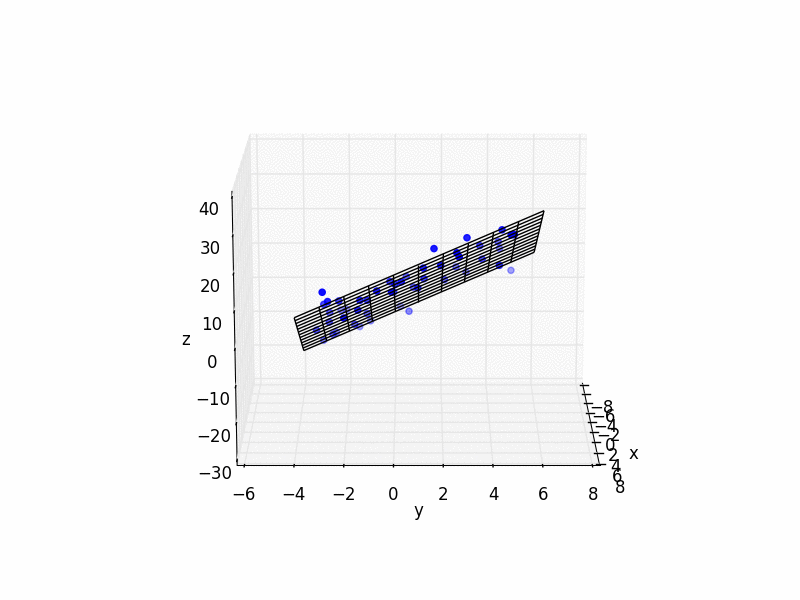3D Least Squares Plane
What's the algorithm for computing a least squares plane in (x, y, z) space, given a set of 3D data points? In other words, if I had a bunch of points like (1, 2, 3), (4, 5, 6), (7, 8, 9), etc., how would one go about calculating the best fit plane f(x, y) = ax + by + c? What's the algorithm for getting a, b, and c out of a set of 3D points?
If you have n data points (x[i], y[i], z[i]), compute the 3x3 symmetric matrix A whose entries are:
sum_i x[i]*x[i], sum_i x[i]*y[i], sum_i x[i]
sum_i x[i]*y[i], sum_i y[i]*y[i], sum_i y[i]
sum_i x[i], sum_i y[i], n
Also compute the 3 element vector b:
{sum_i x[i]*z[i], sum_i y[i]*z[i], sum_i z[i]}
Then solve Ax = b for the given A and b. The three components of the solution vector are the coefficients to the least-square fit plane {a,b,c}.
Note that this is the "ordinary least squares" fit, which is appropriate only when z is expected to be a linear function of x and y. If you are looking more generally for a "best fit plane" in 3-space, you may want to learn about "geometric" least squares.
Note also that this will fail if your points are in a line, as your example points are.
The equation for a plane is: ax + by + c = z. So set up matrices like this with all your data:
x_0 y_0 1
A = x_1 y_1 1
...
x_n y_n 1
And
a
x = b
c
And
z_0
B = z_1
...
z_n
In other words: Ax = B. Now solve for x which are your coefficients. But since (I assume) you have more than 3 points, the system is over-determined so you need to use the left pseudo inverse. So the answer is:
a
b = (A^T A)^-1 A^T B
c
And here is some simple Python code with an example:
import matplotlib.pyplot as plt
from mpl_toolkits.mplot3d import Axes3D
import numpy as np
N_POINTS = 10
TARGET_X_SLOPE = 2
TARGET_y_SLOPE = 3
TARGET_OFFSET = 5
EXTENTS = 5
NOISE = 5
# create random data
xs = [np.random.uniform(2*EXTENTS)-EXTENTS for i in range(N_POINTS)]
ys = [np.random.uniform(2*EXTENTS)-EXTENTS for i in range(N_POINTS)]
zs = []
for i in range(N_POINTS):
zs.append(xs[i]*TARGET_X_SLOPE + \
ys[i]*TARGET_y_SLOPE + \
TARGET_OFFSET + np.random.normal(scale=NOISE))
# plot raw data
plt.figure()
ax = plt.subplot(111, projection='3d')
ax.scatter(xs, ys, zs, color='b')
# do fit
tmp_A = []
tmp_b = []
for i in range(len(xs)):
tmp_A.append([xs[i], ys[i], 1])
tmp_b.append(zs[i])
b = np.matrix(tmp_b).T
A = np.matrix(tmp_A)
fit = (A.T * A).I * A.T * b
errors = b - A * fit
residual = np.linalg.norm(errors)
print "solution:"
print "%f x + %f y + %f = z" % (fit[0], fit[1], fit[2])
print "errors:"
print errors
print "residual:"
print residual
# plot plane
xlim = ax.get_xlim()
ylim = ax.get_ylim()
X,Y = np.meshgrid(np.arange(xlim[0], xlim[1]),
np.arange(ylim[0], ylim[1]))
Z = np.zeros(X.shape)
for r in range(X.shape[0]):
for c in range(X.shape[1]):
Z[r,c] = fit[0] * X[r,c] + fit[1] * Y[r,c] + fit[2]
ax.plot_wireframe(X,Y,Z, color='k')
ax.set_xlabel('x')
ax.set_ylabel('y')
ax.set_zlabel('z')
plt.show()
